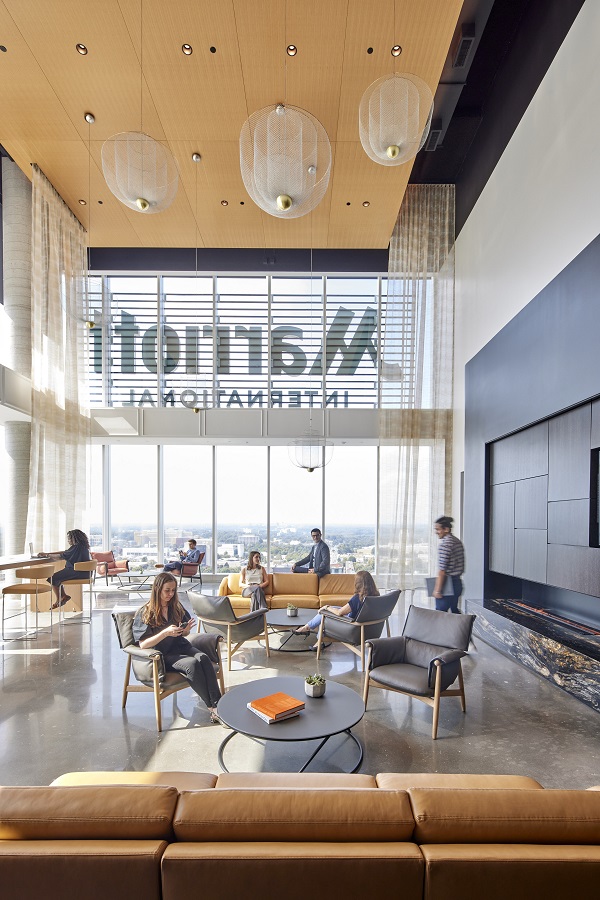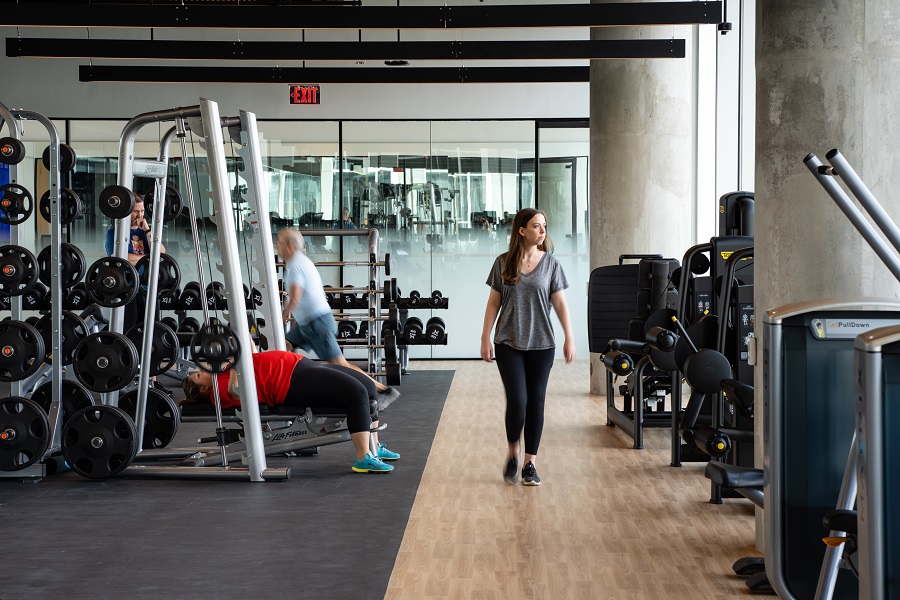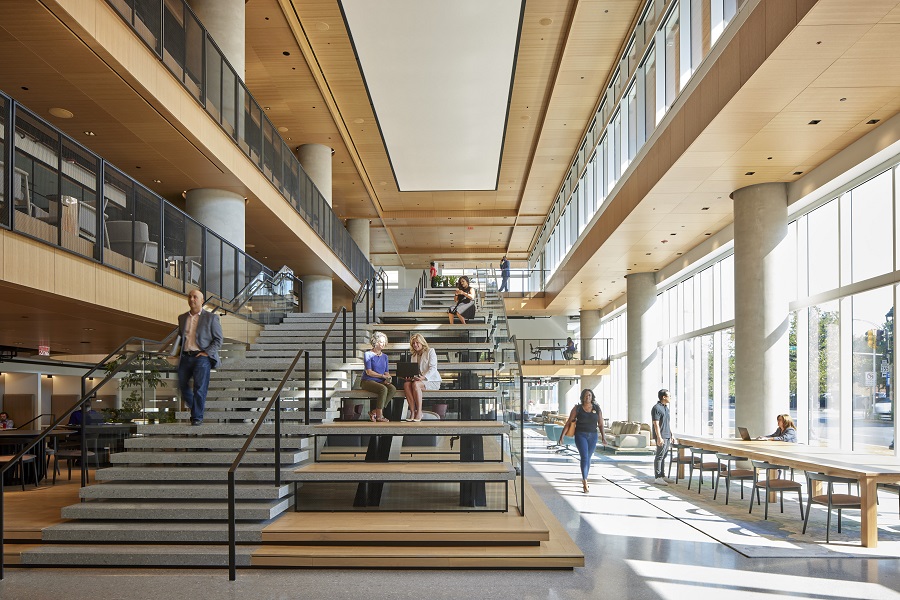Boosting Asset Value Through Fit Buildings
Joanna Frank of Fitwel on the links between healthy buildings, occupant wellness and commercial real estate values.
The Founder & President of Fitwel, Joanna Frank, started her career as a real estate developer. Yet, the challenging landscape of 2008 encouraged her to change paths and, in 2010, she transitioned to a role within the Bloomberg mayoral administration in New York City, where she spearheaded two multi-agency initiatives that laid the foundation for what we now recognize as “the healthy building movement.” Specifically, upon the conclusion of Mayor Bloomberg’s term in 2012, Frank established the Center for Active Design to propel the concept of active design onto the international stage.
She became the leader of this transformation and, over the past decades, her efforts paid off as the Active Design Guidelines were downloaded in more than 180 countries, influencing the design of buildings and infrastructure projects worldwide. The Active Design Guidelines provided the foundation for Fitwel’s multi-faceted approach to improving health and well-being. The healthy building certification standard was originally created by the U.S. Centers for Disease Control and Prevention and General Services Administration, with the CDC remaining the research and evaluation partner for Fitwel.
In the interview below, Frank expands on how Fitwel is equipping real estate players with the tools they need to prioritize health and well-being within the buildings they own or manage.
The pandemic has been a major catalyst for the attention real estate owners and managers pay to the health of the people using their spaces, and Fitwel surfaced as the on-point measuring method. How are things now when we’re passed the COVID-19 threat?

The main driver for the demand for healthy buildings is a growing awareness of the direct impact that real estate has on occupant health and well-being, shares Joanna Frank. Image courtesy of Fitwel
Frank: The pandemic undeniably served as a pivotal moment for the real estate industry, propelling a heightened focus on the health and well-being of individuals using these spaces. Fitwel emerged as a highly relevant tool during this time, providing a robust framework to assess and enhance the health and well-being of the occupants of these buildings. However, even as the COVID-19 threat gradually recedes, the significance of Fitwel remains as strong as ever.
In today’s landscape, responsible investing is rapidly gaining traction. Investors are placing increasing emphasis on a company’s environmental, social and governance performance as a crucial factor in their decision-making processes. Fitwel plays a vital role in this context by helping the industry define the S in ESG. We offer strategies for developing and maintaining optimum health-promoting environments for building occupants, helping companies boost their ESG scores and ratings like GRESB.
Recently, we surveyed investors to gauge their views on health and wellness in real estate. The report revealed how COVID-19 has elevated the importance of health in investment decision-making and how respondents intend to enhance their wellness-related asset management strategies in the coming year. It also outlines three major recommendations for how the sector might better incorporate health and wellness initiatives into its ESG strategies. The survey also uncovered that 87 percent of those surveyed experienced demand from their tenants for healthy buildings.
With the pandemic in the rear-view mirror, what is the main driver for healthy building demand? What is currently Fitwel’s focus?
Frank: The main driver for the demand for healthy buildings is a growing awareness of the direct impact that real estate has on occupant health and well-being. The pandemic further accentuated the importance of spaces that prioritize health. Individuals are increasingly valuing environments that promote physical wellness, mental well-being and overall quality of life. Moreover, investors and stakeholders are recognizing the long-term value of properties that prioritize occupant health, productivity and tenant satisfaction. As a result, there is a shift towards incorporating evidence-based design strategies and technologies that enhance indoor air quality, access to natural light, active design elements and overall wellness. This demand is influencing real estate developers, owners and operators to prioritize health-centric features and certifications, thus shaping the trajectory of building design and operation in the coming years.
Fitwel’s post-COVID-19 era focus on equipping investors with tools where they can prioritize health and well-being within built environments transcends competitive advantages; it mitigates risks and aligns with holistic ESG goals. Fitwel’s platform ensures consistent integration of people-centric metrics, quantifying the S in ESG and enabling data-driven decisions across the real estate sector. As the industry shifts toward data-driven solutions, Fitwel leads in standardizing benchmarks for societal health, strengthening ESG strategies and contributing to the industry’s $53 trillion ESG investments. This approach to value creation through health resonates powerfully with leading real estate companies, evident from their adoption of Fitwel for ESG reporting and portfolio-wide impact.
Furthermore, regarding climate change, our focus pivots towards the ‘people’ perspective in the context of climate change rather than solely focusing on supporting carbon reduction or sustainability certifications. Research underscores the inseparable link between the health of the planet and the health of its inhabitants. Fitwel’s approach centers on leveraging the built environment to optimize health in a warming world. We tackle the challenge by examining ways to optimize both the built environment and the planet from a people-centric standpoint. This encompasses strategies aimed at reducing the drivers of climate change while nurturing holistic well-being.
What sets Fitwel apart from other benchmarks?
Frank: What distinguishes Fitwel from other benchmarks is its unique combination of evidence-based strategies and peer-reviewed research. Fitwel stands out by offering a dynamic framework that is rooted in scientific rigor and constantly evolving to address emerging health and well-being challenges. Generated by expert analysis of more than 7,000 academic research studies, Fitwel is implementing a vision for a healthier future where all buildings and communities are enhanced to strengthen health and well-being. It’s the only real estate tech platform to combine benchmarking and certification and, coming online in 2024, ESG metrics, offering what the CDC considers the most impactful strategies based on science.
As investor demand for ESG reporting grows, Fitwel benchmarking offers real estate owners a clear way to incorporate health-related strategies and outcomes across all three categories, but most especially to the least-defined category—Social. According to our Fitwel partners, Fitwel Certification is a validation of what’s being put in their ESG reports as legitimately making an impact on the people living and working inside their properties. By adopting a common set of guidelines, the real estate industry can commit to better environmental initiatives to spark widespread change across the industry. This is a vital joint effort as we work to combat climate change, with the added benefit of making our communities healthier.
Fitwel addresses health as an interconnected system, with no single dominant category or area of focus, and as such, all strategies are voluntary, with no individual prerequisites. We are seeing more and more real estate sustainability directors view health and the environment not only as important priorities but also as two sides of the same coin, recognizing that green buildings are often healthier.
READ ALSO: Inside the Mass Timber Playbook
Share with us some projects you consider flagship healthy buildings.
Frank: Marriott’s Bethesda headquarters is a world-class hospitality organization that recognizes that people are the sources of its innovation and success. With support from Gensler, The Bernstein Cos. and Boston Properties, Marriott International Headquarters in Bethesda, Md., received a Best in Building Health award for the highest-scoring design property in 2022… Fitwel certification and prioritizing health is not only demanded by occupants and customers, but it is also an important tool for attracting and retaining job seekers, offering a place where associates can thrive and focus on physical and mental well-being.
Vornado Realty Trust achieved the Best in Building Health award for the highest-scoring multi-tenant building for THE MART. The property meets 83 percent of the Health Impact Category strategies, reinforcing the emergency preparedness, indoor air quality and water testing programs, and focusing on proper lighting and building access points. Fitwel also supports Vornado’s ESG program and the impact that social programming and positive health practices have on occupants and employees. THE MART is the largest Fitwel-certified building in the world, spanning 4.2 million square feet, making the impact on people significant.
Tishman Speyer teamed up with Fitwel to certify one of the world’s most iconic landmarks—Rockefeller Center. The achievement amplifies Rockefeller Center’s vision to prioritize the physical, mental and social well-being of its occupants and surrounding community. Fitwel’s commitment to health through building design and operation paired well with Tishman Speyer’s desire to create beautiful spaces that foster community and productivity.
Tell us about the benefits—physical and mental—active design strategies have in real estate developments.
Frank: Fitwel offers a comprehensive pathway towards addressing the indoor and outdoor built environment interventions that support holistic health. Across asset types, a Fitwel building certification addresses not only air quality, biophilia and daylight access, but also offers a wide array of other opportunities to support mental and social well-being, from walkability to community destinations, outdoor lighting, farmers market access and more. By incorporating Fitwel design strategies, not only do they help reduce stress but also boost emotional well-being, improve productivity and focus, and foster a positive holistic health—social, emotional and physical well-being.
Biophilia has made a comeback in recent years and pairs up seamlessly with Fitwel. Which are your preferred biophilic design solutions?
Frank: In the era of climate change and pandemic risk, how building design for public health will evolve will shape the future. This, combined with a growing number of people spending much of their time indoors, there is an abundance of evidence to suggest that creating connections between nature and the built environment can increase our well-being.
We are seeing more buildings incorporate biophilic design elements, bringing nature indoors with living walls, green roofs and extensive use of natural materials. This approach will improve air quality, reduce stress and enhance occupants’ overall well-being. Design interventions that can enhance this connection in both our outdoor and indoor environments include views of nature, incorporating natural materials into the design—wood, rock, water—providing access to natural light, plant walls, potted plants, hydroponic gardens, hanging plants and water features. Other outdoor designs include greenways, gardens, serene spaces, and restorative spaces like forests, parks, or greenery along streets and urban areas.
How many Fitwel-certified projects are there in the U.S. and globally? Which areas lead in registered and awarded Fitwel certifications?
Frank: There are more than 1,500 certified projects globally, spanning across more than 50 countries; 1,125 of these are in the U.S. Office projects make up for more than 50 percent of these certifications, encompassing both building owners and tenants. Some recognizable names among these certifications include Meta, Microsoft and Peloton.
Multi-tenant base building properties account for approximately 30 percent of all Fitwel-certified buildings. Commercial properties account for more than 20 percent of all Fitwel-certified buildings.
Interestingly, the residential sector is experiencing rapid growth in the post-COVID-19 era. This growth is particularly evident in the increasing adoption by residential REITs. In terms of market distribution, the U.S. stands out as our largest market, constituting 79 percent, while California leads in most certified projects at more than 250. Additionally, Fitwel has gained significant traction in other prominent markets such as Canada and the U.K.
Tell us about the Fitwel Standard v3 slated to launch in December. What prompted these changes?
Frank: Fitwel Certification has never been more important in future-proofing assets and portfolios. We regularly evolve the Fitwel Standard to ensure it reflects the most recent research and evidence, is responsive to input and insights from our users, and is optimized for resiliency, impact and value. The current version, Fitwel v2.1 includes clarified strategy language, expanded pathways for compliance, and various strategy requirement updates. Since its launch in 2018, Fitwel v2.1 has proven to be scalable, globally relevant, adaptable to various asset classes and types and reflective of market demand.
Version 3 (v3) of the Fitwel Standard reflects insights from the latest public health research and data-based evidence substantiating the valuable link between health and the built environment. Additionally, it offers a streamlined and more efficient documentation and certification process, easy-to-use resources and tools, and several tech enhancements to improve the overall user experience.
Meanwhile, we are excited about our September launch of Fitwel’s Certified Metrics Module pilot that we created in collaboration with EVORA Global, a groundbreaking step in ESG reporting for real estate investors. This tool standardizes and substantiates social impact data, addressing the need for a unified approach to measuring and reporting the S in ESG. The pilot provides rankings and insights for certified projects, focusing on strategies that impact health and material risk, offering valuable information for investment decisions. The Certified Metrics Module involves industry leaders such as Alexandria Real Estate Equities, Tishman Speyer, BentallGreenOak, and more, driving global adoption of these metrics.















You must be logged in to post a comment.